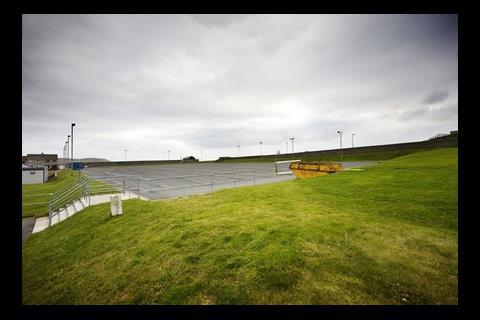Shetland is a 13-hour ferry ride from mainland Britain and is closer to the Arctic Circle than to London, so when its main school fell into disrepair, the islanders faced a struggle finding someone to build a new one.
There are few more spectacular examples of nature’s majesty than the rugged landscape of the Shetlands. The islands were recently voted in the top 10 of places in Britain to retire to. Shetland even has shorter waiting lists for hospital treatment than many other parts of the country.
But don’t be deceived. It’s grim up north. Especially when you are trying to find a contractor for a multimillion-pound project. If it’s difficult to find builders for a project on the outside edge of the M25 at the moment, imagine trying to entice a firm to build in a place that is 100 miles north of the British mainland, nearer to the Arctic Circle than London, and reachable only by a 13 hour ferry trip.
Shetland Islands council has spent almost two years trying to find a contractor willing to put up a new building for Anderson high school in Lerwick, Shetland’s capital and Britain’s most northerly town. The fabric of the existing 19th-century listed school is in poor condition and requires an increasing amount of maintenance, which provides a constant source of disruption for teachers and students alike.
Despite a £48m price tag, the remote location and the wealth of work available elsewhere deterred contractors from tendering. This forced the council to abandon the tender process earlier this year, leaving construction of the much-needed school in doubt.
“You could say it’s a geographical problem,” says Craig Nicolson, the council’s senior project manager. “With an abundance of work on the mainland, we just couldn’t attract contractors to come here.
“It was disappointing. We thought of the scheme as a prestigious project, one that would attract a lot of interest. The realisation that perhaps it wasn’t so prestigious for mainland firms forced us into a rethink about how we could make it attractive to them.”
So the council phoned a friend. George Dunlop, procurement and partnering manager at consultant Knowles, listened and offered a solution. “I helped with an earlier scheme on Shetland which worked out well, so they approached me again,” says Dunlop.
“I felt the best way forward was to use a partnering framework with a target price and open books.
“The change in attitude from contractors was evidenced by the fact that the project went from no interest just over nine months ago to a shortlist of three strong contenders, from which one was selected.”
The winning contractor was not a relatively local Scottish company, but Northern Irish firm O’Hare & McGovern. The Newry-based contractor is an experienced island-hopper, however. It is now nearing completion on a £42m prison in the Isle of Man, which involved the firm flying in its own workforce as well as using local labour and subcontractors. It will do the same on Shetland.
We thought it was a prestigious project, one that would attract a lot of interest. The realisation that perhaps it wasn’t so prestigious for mainland firms forced us to rethink
Craig Nicolson, Shetland Council
“The school is just another part of our expansion programme,” says Eamon O’Hare, the contractor’s managing director. “We’re looking further afield, particularly at the Scottish market, and wherever we go in Scotland we’re going to need to get on a plane, and move men and materials there. In that respect, Shetland isn’t any different to working in Glasgow or Edinburgh for us.”
Well, up to a point. Home to just 22,000 people, Shetland lies on latitude 60° north, surrounded by the unforgiving waters of the north Atlantic. It is lucky to get six hours of daylight in winter and is also prone to the odd hurricane. Although served by a nightly ferry from Aberdeen, the journey takes 13 hours. There are daily flights from Scotland’s main airports, but if someone forgets to pack the structural steel bolts, they cannot simply nip around the corner for a replacement.
With that in mind, it is perhaps not surprising that, while looking for a contractor to build the school, the council asked firms what kind of contract would entice them to come. “They all said design and build and open book, so that is what we adopted,” says Nicolson.
The shift to a design-and-build tender led to the departure of the project architect, Building Design Partnership (BDP), which had spent two years working on the scheme. But because of the NEC partnering system now employed in the contract, the school, which retains BDP’s concept design, is likely to be built for about 15-18% less than last year’s £48m estimate.
“If the contractor is under the target price, they’ll get a bonus,” says Dunlop. “If they are over it, they will lose out. It’s a pain/gain contract, but one that will benefit both parties and cost less than the original price.”
Much secrecy surrounds the target price, but it is understood to be about £40m.
That figure is only made possible by the openness of the client and contractor in discussing all the costs involved, which in turn offers an effective guarantee of overhead and profit. In this type of contract, it is not unusual for the contractor to be entitled to about half of whatever cash is saved below the target figure.
But the contractor has some unusual problems to overcome in achieving its target. For one, this is no standard school design. Windswept winters and long dark days mean the school needs more inside areas. O’Hare, whose firm has built a number of PPP schools in Northern Ireland, explains: “There is a lot more indoor play and relaxation space in this school because of the weather. It’s peculiar, but with design and build we can easily manage it all into the design.”
In addition, pupils aged 16 to 18 account for more than a third of the school’s 900-plus pupils, which affects the design. Valerie Nicolson, the school’s headteacher, says: “We take in a large number of 16-year-olds from smaller schools on Shetland. That means we have a higher proportion of pupils studying Highers [the Scottish equivalent of A levels] than most schools. So, for example, in science subjects we require larger labs than the average school of our size.”
To make sure the new school fits the brief, Nicolson got involved in the tendering process. “It’s been a steep learning curve,” she says. “But having learned the construction terminology and been part of the discussions with the contractor, I’m optimistic about how the design will fit in with our specific requirements.”
There is a lot more indoor play and relaxation space in this school because of the weather …
Eamon O’Hare, contractor
The scheme still has to be approved by the council. The project was criticised after its initial price estimate of £30m two years ago jumped to £48m on the back of rising construction prices. A vote is scheduled to take place in March, when the fixed price has been agreed and submitted it to the council.
O’Hare remains confident that the project will get the go-ahead. “We’re looking to start work in April,” he says. “Our plan is to get the roof on by November at the latest and then work inside. There’s not a lot of sunlight during winter but you get about 19 hours of daylight during the summer. So we’ll tailor our schedule to accommodate that.“
About 120 full-time workers will be on site for the two-year duration of the scheme, and most will commute from Belfast. To accommodate the influx, the council will convert some empty listed buildings next to the school into a hostel.
“We usually work fortnightly shifts, where staff arrive on a Monday and leave 12 days later on the Friday,” says O’Hare. “We’ve got an arrangement with a private airline to lay on flights for us every Monday and Friday. I can see a point where we’ll be running three flights a week between Belfast and Shetland. It’s all factored into the cost.”
O’Hare, Dunlop, and Craig and Valerie Nicolson all stress that the project will provide jobs for Shetland locals. “We haven’t gone into detail yet because of the change to design and build,” says Craig Nicolson. “A lot of the work will be prefab, but we will be looking to use the local workforce, too.”
Valerie Nicolson adds: “It will generate local employment. Some of our 15 and 16 year olds may well end up serving their time on the construction of the school.”
The bulk of the materials, including an estimated 2,000 tonnes of steel, will be shipped from Britain and Europe, prompting images of an Armada of boats filled with building materials converging on the island.
“The easy bit is done now,” says Dunlop. “The logistical work to put it all together on site will be the hard bit.” But O’Hare is philosophical about the task ahead. “The logistics are a bit worrying, but also a tremendous challenge.”
Whatever happens on site, the council is already planning to use the procurement route again. “We’ve got an £8m junior high school due to be advertised soon and we’re going to do it exactly the same way,” says Craig Nicolson. “After all, Shetland isn’t really any more of a challenge to work in than any other remote place.”
Postscript
For more school projects, search www.building.co.uk/archive




























No comments yet